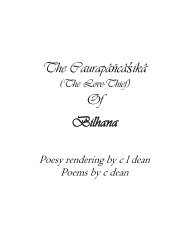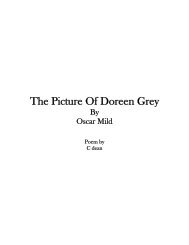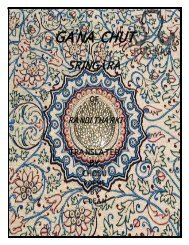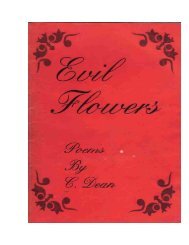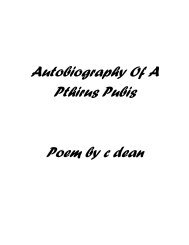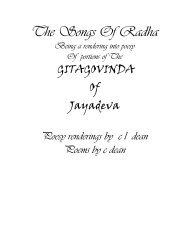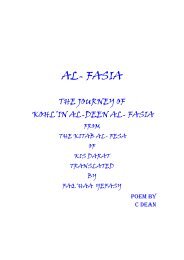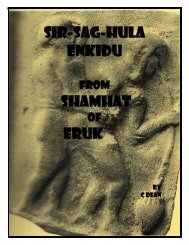FASAD AL-ZAMAN - Gamahucher Press
FASAD AL-ZAMAN - Gamahucher Press
FASAD AL-ZAMAN - Gamahucher Press
You also want an ePaper? Increase the reach of your titles
YUMPU automatically turns print PDFs into web optimized ePapers that Google loves.
V<br />
pearl bejewelled sandals with hair in musk<br />
perfumed bangs wide gold brocaded rose coloured<br />
sleeves and a long blue satin train to his pink<br />
robes he was the leading exponent of mujun 5<br />
poetry 6 in his Asr al-Intihat 7 where the<br />
colloquial and no metre 8 was used and form<br />
the sense to be compared to hippies and punks in modern Western society There is a distinctive ”look”<br />
we learn from a description of Abu Nuwas himself who adopted it… when he travelled to Egypt “the<br />
garb and cut of clothes of the shutter with hair in bangs wide sleeves and a train to his robes and<br />
covered sandals”… they are not to be identified with male prostitutes<br />
5 Profane libertine or dissolute poetry<br />
6 Arabic poetry العربي,Arabic) (الِشعر is the earliest work of Arabic literature. It is composed and written down in<br />
the Arabic language either by Arab people or non-Arabs. Knowledge of poetry in Arabic dates from the 6th<br />
century but oral poetry is believed to predate that. Arabic poetry is categorized into two main types, rhymed or<br />
measured, with the earlier greatly preceding the latter. The rhymed poetry falls within fifteen different meters<br />
collected and explained by Al-Farahidi in what is known as ملع“ ”ضورعلا (The Science of Arood). Al-<br />
Zamakhshari later added one more meter to make them sixteen. The meters of the rhythmical poetry are known in<br />
Arabic as ”روحب“ or Seas. The measuring unit of the “seas” is known as ”ةليعفت“ (Taf’eela) with every sea<br />
containing certain number of Taf’eelas that the poet has to observe in every verse (bayt) of the poem. The<br />
measuring procedure of a poem is very rigorous. Sometimes adding or removing a consonant or a<br />
vowel could shift the bayt from one meter to another. Also, in rhymed poetry, every bayt has to end<br />
with the same rhyme (qafiya) throughout the poem. With the expansion of Islam into Persia, Arabic<br />
language was greatly enriched by Arabic grammarians and writers of Persian descent. The new<br />
converts had also major contributions to Arabic poetry. The quality of Arabic poetry composed has, at<br />
times, deteriorated especially during the Mamluks era and onward. In the 20th century, there has been a<br />
resurgence of the language for literature and poetry particularly in Egypt and Lebanon.<br />
7 age of decadence<br />
8 Classical ArabicClassical Arabic has sixteen established meters. Though each of them allows for a<br />
certain amount of variation, their basic patterns are as follows, using "-" for a long syllable, "u" for a short<br />
one, "x" for a syllable that can be long or short and "o" for a position that can either contain one long or<br />
two shorts:<br />
:(ليوطلا) 1The Ṭawīl<br />
u-x u-x- u-x u-u-<br />
نليعافم نلوعف نليعافم نلوعف<br />
:(ديدملا) 2The Madīd<br />
xu—xu- xu-<br />
نتالعاف نلعاف نتالعاف<br />
:(طيسبلا) 3The Basīṭ<br />
x-u- xu- x-u- uu-<br />
نلعف نلعفتسم نلعاف نلعفتسم<br />
:(لماكلا) 4The Kāmil




